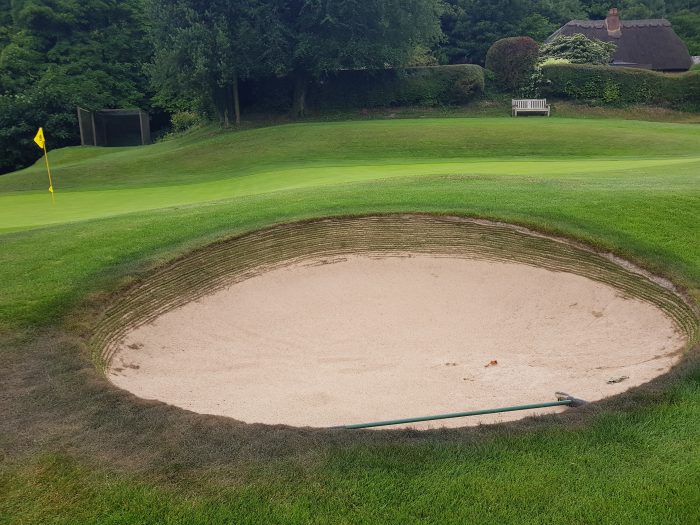Epping Golf Club uses glass instead of sand in its bunkers
Neil Sjoberg, the manager of Epping Golf Club who built his club from scratch, has revealed that he uses glass for sand in his course’s bunkers, as part of his club’s environmental strategy.
Epping was built in 1996, but due to costs and the course layout, it never had bunkers. However, a mixture of repeated requests from members for them and the fact that bunkers act as golfing advertisements to passers-by (the club faces restrictions on conventional advertising signs), Epping last year decided to install five bunkers.
“After a quick greenkeepers’ meeting we got the spray can out and marked five areas,” said Neil. “Our criteria for positioning would not be found in books by Hawtree or Cotton. Instead they were to be near the greenkeepers’ hut for easy maintenance access, to be highly visible from the M11, M25 and the clubhouse, to toughen some par fours that are now driveable and to be put in positions where they will not be used too much and so minimise raking!”
Unusually for a golf club, Epping sourced glass sand for the project. This was through the Waste and Resources Action Programme (WRAP) and Recyclable Market Development (ReMaDe) Essex. Local firm Day Group delivered the sand within 24 hours – and at a cost of £17 per ton, considerably cheaper than the £62 per ton the club was offered for top silica sand, and also cheaper than any of the other sand alternatives the club could purchase. But Neil had several concerns about using recycled glass in bunkers.
“I was worried about the damage to mower blades, the appearance of the sand, drainage and playability and what maintenance and recycling policy we might need,” he said. Fortunately ReMaDe Essex, a recycling project, explained that the damage to the blades was no worse than the normal sharp sand, the appearance would be slightly green and the playability and drainage would be excellent. Neil ordered 60 tons.

A bunker at a different golf club
“A few days later we used our chain trencher to run the drains to the bunker shapes and filled in the trenches with drain, pea shingle and topping off ash, so not to disrupt weekend play with open trenches,” he said. “We managed to use much of the oversized sand in the drainage runs.
“Much of the turf was reversed to form the bunker base and I spent a morning collecting geosynthetic membrane to line them. Some of the bunkers were then ready to play with seeded banks roped off.
“The following week the digger returned and we completed the landscaping. By then we had fairly well caught up on the routine maintenance that had taken a back seat for ten days or so. Recently I top dressed an area of turf with the glass sand to see if the claims of reduced worm casting were valid. To date the results seem promising but inconclusive.”
Within two months the bunkers were fully in use and the GUR lines were removed. The golfers all seemed happy with the new bunkers which play and drain well.
“The total cost of the five bunkers, including labour, was less than £5,000,” said Neil.
“I am aware that, although very acceptable, the finished results do not come up to the high standards of beautiful landscaping I have seen elsewhere. On the other hand one of our main aims is to keep subscriptions and green fees down, and respond to golfers’ requests.
“The exercise does hold a stark contrast to the committee meetings, members’ consultations and expense that one experiences at clubs often dealing with smaller projects. I really hope that this helps some secretaries persuade their committees to trust them to push ahead with similar projects.
“Boldness has its rewards.”















Email from Neil Sjoberg: Top quality (Silica) bunker sand can cost up to £60 ton and is exactly the same as crushed recycled glass which is often given away for transport cost only.
At The Epping Golf Course (“Quality golf without the price tag”) with 16 other golf facilities within 8 miles we are anxious to
a. Give golfers value for money
b. Be environmentally friendly
c. Think for ourselves.
We built the course 15 years ago and under great pressure from members to install bunkers our first loads of bunker sand came from Day aggregates and was free.(They had a surplus of recycled glass at their Brent depot so we paid transport only.
It takes about 10 tons to fill an average sized new bunker and the first delivery of glass sand had some surprises.Being made from crushed bottles it is available in Clear, Green or brown. It also still carries the residue of the glue that sticks the label on and smells (you guessed it ) just like your lounge the morning after a new years eve party!
The first shower of rain completely dispel the smell and the clumps caused by the glue but you still get the occasional glink of sunshine catching an angle.
Even clear glass sand still has a greenish tint but it has big benefits:
Very good playing characteristics
Drains well and does not clog or puddle up in rain
Very easy to rake
If not raked will settle into a smooth pattern with wind or rain.
Does not wash out in heavy rain
After the early sceptics glasssand is now here to stay and we built three new bunkers ourselves this February for a grand total cost of £1000 (yes £1000) all in cost in one week, along with other greenkeeping duties. They actually look inviting to play from and hold the ball up so you dont get pluuged lies.